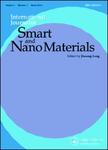Numerical study on the electromechanical behavior of dielectric elastomer with the influence of surrounding medium
有包围媒介的影响的绝缘的弹性体的机电的行为上的数字学习作者机构:State Key Laboratory for Strength and Vibration of Mechanical StructuresSchool of Aerospace EngineeringXi’an Jiaotong UniversityXi’anChina
出 版 物:《International Journal of Smart and Nano Materials》 (国际智能和纳米材料杂志(英文))
年 卷 期:2016年第7卷第1期
页 面:52-68页
核心收录:
学科分类:07[理学] 0701[理学-数学] 070101[理学-基础数学]
基 金:This work was supported by NSFC under Grant(11321062 and 11402186,11402185) China Postdoctoral Science Foundation under Grant(2015M572548)
主 题:Dielectric elastomer electromechanical coupling finite element method Maxwell stress tensor
摘 要:The considerable electric-induced shape change,together with the attributes of lightweight,high efficiency,and inexpensive cost,makes dielectric elastomer,a promising soft active material for the realization of actuators in broad ***,a number of prototype devices have been demonstrated in the past few years,the further development of this technology necessitates adequate analytical and numerical ***,previous the-oretical studies always neglect the influence of surrounding *** to the large deformation and nonlinear equations of states involved in dielectric elastomer,finite element method(FEM)is anticipated;however,the few available formulations employ homemade codes,which are inconvenient to *** aim of this work is to present a numerical approach with the commercial FEM package COMSOL to investigate the nonlinear response of dielectric elastomer under electric *** influence of surrounding free space on the electric field is analyzed and the corresponding electric force is taken into account through an electric surface traction on the circumstances *** employ-ing Maxwell stress tensor as actuation pressure,the mechanical and electric governing equations for dielectric elastomer are coupled,and then solved simultaneously with the Gent model of stain energy to derive the electric induced large deformation as well as the electromechanical *** finite element imple-mentation presented here may provide a powerful computational tool to help design and optimize the engineering applications of dielectric elastomer.



